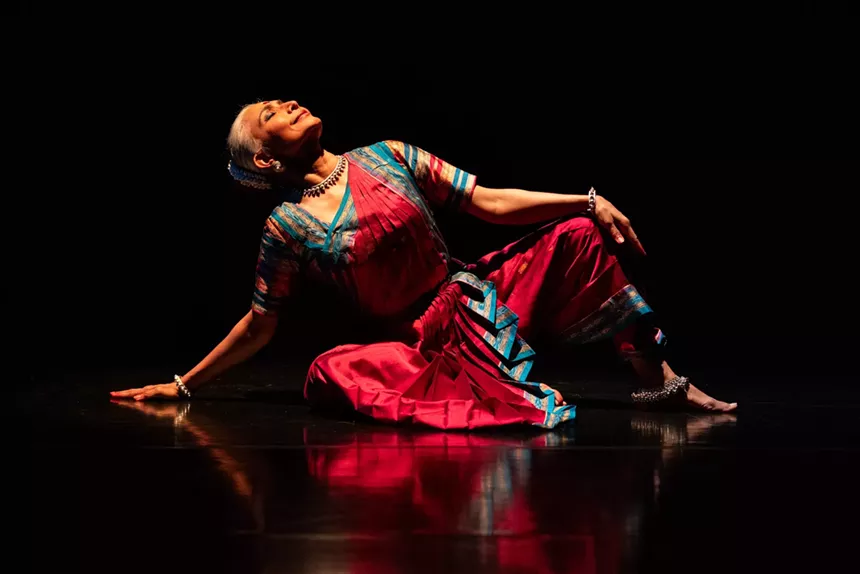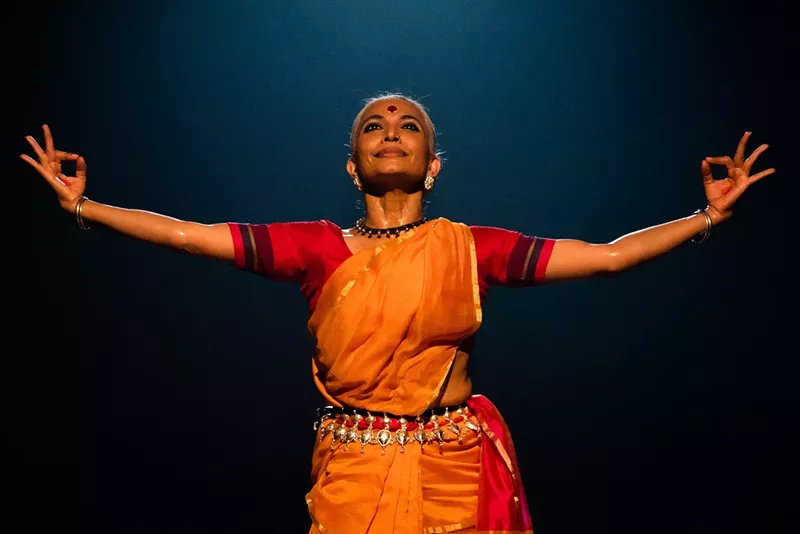Satpathy, who will perform her choreography on Saturday, March 9, at Miami Dade College's North Campus as part of Live Art Miami's spring season, was first exposed to Odissi in kindergarten. When her teacher discovered the little girl dancing alone in an adjoining room, she suggested that her father take the child to formal dance classes. After 13 years of study, she was chosen at 20 years old to perform with the Nrityagram dance troupe in its premiere United States tour. Satpathy imagined herself returning to her ordinary life in Orissa in eastern India at the tour's end; instead, she remained with the group for 25 years.
Odissi's roots run deep. One of the eight classical dance styles of India, the sensual s-like curve of the spine in Odissi can be seen in temple carvings, with the statuary serving as a resource text for the development of the dance's postures. Narrative dances tell the stories of religious deities, while other choreographies emphasize abstract principles and the interplay of complex rhythmic patterns.
At the Nrityagram compound, where Satpathy lived as part of the troupe, she and the other young women in her cohort ate, drank, slept, and dreamt Odissi dance 24/7.
"I came to Nrityagram, and the understanding was it was just a tour. I would rehearse, learn some new choreography that they were presenting, and go back home after," she says. "But as soon as I walked into this place, which is in rural Bangalore, many, many, many hundreds of kilometers away from my place, Orissa, and in a rural area, quiet, ten acres of beautifully built huts and open dance spaces, open to nature, I fell in love the first day I landed there and decided, 'This is going to be it for me.'"
It was not merely a pastime but a way of life, she says, and the ideal place for a young person to dedicate her heart and soul to her training.
"We would wake up very early in the morning and go for a jog or a walk, and then there would be one and a half hours of conditioning," she says.
One daily class might be dedicated solely to eye movements. Another would be focused on the hands and Odissi's codified language of gestures. There was choreography to be learned and rehearsed, but there was also the vegetable plot to tend to, laundry to be washed, and village neighbors to help.
It was, she says, "very, very simple living."
For years, she was the star of Nrityagram. And yet, at 45, after spending more than half of her lifetime in this Shangri-la dream of a dance village, she left. Like Thoreau heading off to his cabin at Walden Pond, Satpathy's creative spirit sought solitude. Sensing that there was much yet to uncover in the traditional dance style that she had loved so devotedly, she embarked alone on a new path, intent on coming closer to the essential truths of her art form.
"It was a decision I took very fearfully because I was always in community. I had never known dancing solo," she says. "I had a need, but I couldn't put my finger on it." Then, the pandemic arrived, and solitude became obligatory for nearly everyone.
"I started relishing the solo journey," she says. "I suddenly realized that I had more time and space to go even deeper within."

Bijayini Satpathy was discovered as a dancer by her kindergarten teacher, who saw the child dancing and urged her father to get her proper lessons.
Photo by Maria Baranova, courtesy of Live Arts Miami
"I soon realized while working solo that I had all that mind and time to myself," says Satpathy. "I had more time and space to go even deeper within. Within the inner workings of a movement, just a movement pattern, even if there was no story. And if there was a story, then deeper into the character I was depicting." It is a freedom that allows her, she feels, to take Odissi to a different level.
"I free myself as much as I can to express what is intrinsic to Odissi. In Odissi, there is a constant state of surrender and devotion," she says. "In my solo practice now, I find myself more and more in the dance, in the sense that there is a certain inner journey which runs parallel to the experience of the dance."
It is a journey that has been acclaimed by heavy-hitters of the dance world, like the Baryshnikov Dance Center and Duke University, which commissioned the choreography Satpathy will perform in Miami.
Rajika Puri, a prominent figure on the New York world dance scene for years and an expert on Odissi and Bharatnatyam, has followed Satpathy's career for decades.
"I can say that I think the path Bijayini's on is amazing," Puri says in an email exchange from India. "I've watched her grow since she joined Nrityagram. It's a joy to watch her perform."
Satpathy herself feels that her development has been personal as well as artistic.
"I expand, you know, I grow in confidence when I play a very powerful character as a human being. It's like the day you learn to drive or swim, you grow in confidence one inch." Beyond personality, this exploration touches on gender mores as well.
In Odissi, she explains, "We have no time, space, gender, self-identity boundaries. As a female-bodied person, identifying as female, I must play all characters convincingly. Male, female, amazing characters that are so interesting, larger than life, unbelievably powerful, or even vulnerable. Accessing those beings expands me as a human being, I feel."
One of the payoffs of playing these potent personalities onstage is courage — the courage to speak boldly as a woman living in what the dancer describes as India's highly patriarchal society.
"Because of the dance," she says, "I am able to tell a story in a very confident way about the truth of certain taboos that exist in India still where women are marginalized. They're not equal to men."
Ideas around gender, she says, have always intrigued her.
"What is my idea of masculine?" asks Satpathy. "What is my idea of feminine? Sometimes, this is what society has taught us — that you stand a certain way, and that is feminine. You stand a certain way that is unfeminine. My mother has corrected me many times," she says wryly.
For her, dancing has brought with it empowerment.
"Sometimes I feel like my interpretations now are of the same stories, but the mythological stories are now being informed by who I have become internally because of the dance," she says. "I feel like dance really empowers the person that is dancing it."
Puri, who clearly sees the power in Satpathy's artistry, doesn't mince words.
"She is among the top five dancers I've ever seen — and I've watched [British ballet star Margot] Fonteyn since I was 5, [Indian dance star] Balaraswati since I was 12, [Russian ballet star Galina] Ulanova since I was 18. She is among the best."
– Helena Alonso Paisley, ArtburstMiami.com
"Abhipsaa: A Seeking." 8 p.m. Saturday, March 9, at the Lehman Theater at Miami Dade College North Campus, 11380 NW 27th Ave., Room 1315, Miami; 305-237-3010; liveartsmiami.org. Tickets cost $29 to $39.













